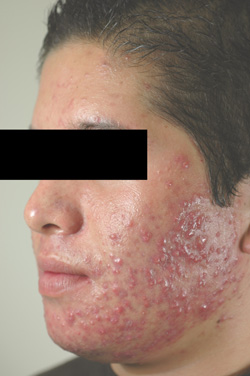Photodynamic Therapy (PDT) is one of the newer and more novel treatments for actinic keratoses. PDT involves the application of a photosensitizing agent to sun damaged skin. There are two commonly used photosensitizing agents: aminolevulinic acid (ALA) and methylaminolevulinate (MAL). Only ALA is available in the United States. It is sold under the brand name Levulan and is packaged in a Kerastick formulation. Essentially, the ALA is a liquid within a tube that appears like a Glo-stick. The liquid is released similar to how a Glo-stick is activated, by bending the Kerastick in half. The skin is prepared for the Kerastick application by using acetone to clean all of the dirt and oil from the skin. One end of the Kerastick is rubbed across the entire skin applying a thin layer of Levulan. The patient must allow for a 30 minute incubation time while the Levulan is absorbed into the skin. The key element enabling Levulan to work on actinic keratoses and not normal skin is that pre-malignant and malignant cells preferentially absorb Levulan, whereas normal cells have a lower affinity for the uptake of Levulan. The cells convert Levulan into a photactive chemical called protoporphyrin IX. When protoporphyrin IX is exposed to light, it releases a free radical oxygen molecule that is very damaging and it destroys the actinic keratosis from inside the cell. After this 30 minute incubation time, the patient is placed under a light source. The two most common light sources are a laser/intense pulse light and a blue light (Blue-U). The Blue-U is the more commonly used light source and appears like a sunlamp. The patient spends approximately 20 minutes under the Blue-U. Afterwards, the treated area is gently cleansed and the patient is under strict sun protection orders for the next 48 hours. Any further UV exposure, can create a very serious burn as the protoporphyrin IX is still present and can be further activated. Essentially, the patient is confined to his/her home for two days. The treated area appears like a very bad sun burn but after one to two weeks the skin is fully recovered and usually looks rejuvenated and the number of actinic keratoses is significantly reduced. Due to the cumbersome nature of this treatment and risk of further activation of the protoporphyrin IX with serious consequences, I do not offer this treatment in my practice; however, it is a good option for a very select group of patients.





